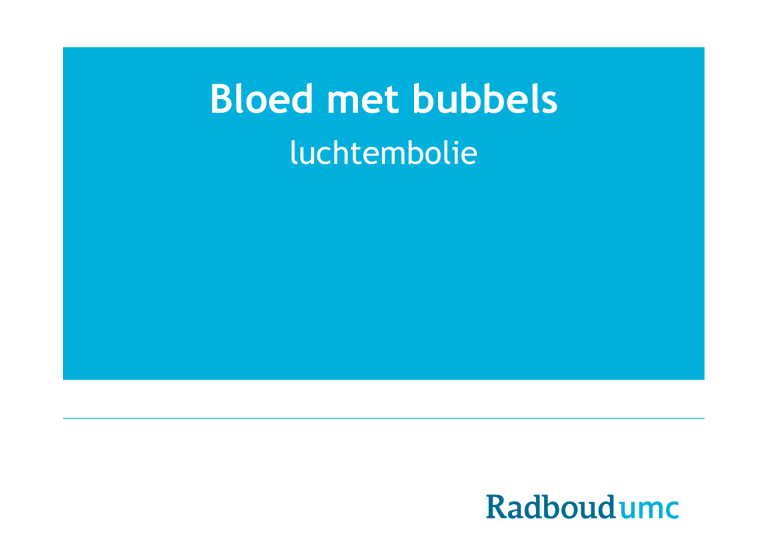
Bloed met bubbels
luchtembolie
Pathofysiology
• lucht of exogeen gas via operatiegebied of andere toegang in
veneuze/ateriele vasculatuur -> systemische effecten
• 2 factoren
• Volume/ Snelheid
• Spontane of gecontroleerde beademing
• lethaal volume: 200-300ml (3-5 mg/kg)
• Afstand tot rechter hart
• M.n. case-reports/ dierenstudies
•
Verschil met CO2 embolie: oplosbaarheid in bloed
Pathofysiologische scenario’s
•
Massale luchtembolie (5ml/kg) -> gas air-lock
• Complete outflow obstructie -> acuut rechtsfalen
•
Kleinere volume -> outflow obstructie
• Daling CO, hypotensie, myocard en cerebrale ischemie
•
Luchtembolie in pulmonale circulatie
• Vasoconstrictie, release ontstekingsmediatoren,
brochoconstrictie -> V/Q mismatch -> dode ruimte
ventilatie -> EtCO2
•
Luchtembolie in cerebrale circulatie
• Patent foramen ovale
Diagnosis and Treatment of Vascular Air Embolism.
Mirski, Marek; Lele, Abhijit; Fitzsimmons, Lunei; Toung, Thomas
Anesthesiology. 106(1):164-177, January 2007.
Klinische presentatie
•
Symptomen komen overeen met (long)embolie
• Dyspnoe/ tachypnoe
• Thoracale pijn
• Tachycardie
• Hypotensie
• ECG #
• Bewustzijnsdaling
• Circulatoire shock en overlijden
Detectie van luchtembolie
•
•
•
•
•
•
•
TEE
• Meest sensitief -> 0,02ml/kg
Precordiale/ transcraniele Doppler
EtCO2
ECG
• Tachycardie/ as deviatie/ ST depressie/ Strain
Lab:
• hypoxie/ hypercapnie/ acidose
Pulsoximeter
Human factor
Behandeling
•
‘Verloop is redelijk voorspelbaar en therapie supportive’
•
•
•
•
•
•
Voorkom verergering -> harthoogte
100% zuurstof -> verdringing andere gassen
Aspiratie van lucht
Hemodynamische ondersteuning
Hyperbare zuurstoftherapie
Hemodynamische ondersteuning
Mirski et al, Diagnosis and Treatment of Vascular Air
Embolism, Anesthesiology 2007
